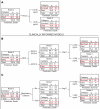Angiopoietin-2 levels are associated with retinopathy and predict mortality in Malawian children with cerebral malaria: a retrospective case-control study*
- PMID: 22343839
- PMCID: PMC3284252
- DOI: 10.1097/CCM.0b013e3182373157
Angiopoietin-2 levels are associated with retinopathy and predict mortality in Malawian children with cerebral malaria: a retrospective case-control study*
Abstract
Objective: To investigate the relationship among the angiopoietin-Tie-2 system, retinopathy, and mortality in children with cerebral malaria.
Design: A case-control study of retinopathy-positive vs. retinopathy-negative children with clinically defined cerebral malaria.
Setting: Queen Elizabeth Central Hospital in Blantyre, Malawi.
Subjects: One hundred fifty-five children presenting with severe malaria and meeting a strict definition of clinical cerebral malaria (Blantyre Coma Score ≤ 2, Plasmodium falciparum parasitemia, no other identifiable cause for coma) were included in the study.
Interventions: None.
Measurements and main results: Clinical and laboratory parameters were recorded at admission and funduscopic examinations were performed. Admission levels of angiopoietin-1, angiopoietin-2, and a soluble version of their cognate receptor were measured by enzyme-linked immunosorbent assay. We show that angiopoietin-1 levels are decreased and angiopoietin-2 and soluble Tie-2 levels are increased in children with cerebral malaria who had retinopathy compared with those who did not. Angiopoietin-2 and soluble Tie-2 were independent predictors of retinopathy (adjusted odds ratio [95% CI], angiopoietin-2, 4.3 [1.3-14.6], p = .019; soluble Tie-2, 9.7 [2.1-45.8], p = .004). Angiopoietin-2 and soluble Tie-2 were positively correlated with the number of hemorrhages, the severity or retinal whitening, and the extent of capillary whitening observed on funduscopic examination (p < .05 after adjustment for multiple comparisons). Angiopoietin-2 and soluble Tie-2 levels were elevated in children with cerebral malaria who subsequently died and angiopoetin-2 was an independent predictor of death (adjusted odds ratio: 3.9 [1.2-12.7], p = .024). When combined with clinical parameters, angiopoetin-2 improved prediction of mortality using logistic regression models and classification trees.
Conclusions: These results provide insights into mechanisms of endothelial activation in cerebral malaria and indicate that the angiopoietin-Tie-2 axis is associated with retinopathy and mortality in pediatric cerebral malaria.
Figures




Comment in
-
A better biomarker for cerebral malaria: in the eye of the beheld?*.Crit Care Med. 2012 Mar;40(3):1018-20. doi: 10.1097/CCM.0b013e31823d7810. Crit Care Med. 2012. PMID: 22343865 Free PMC article. No abstract available.
-
Low angiopoietin-1 as a predisposing factor for cerebral vasospasm in cerebral malaria.Crit Care Med. 2012 Dec;40(12):3333-4; author reply 3334. doi: 10.1097/CCM.0b013e318267a8d4. Crit Care Med. 2012. PMID: 23164793 No abstract available.
Similar articles
-
Vital Sign alterations within 24 hours prior to death in children with retinopathy-positive Cerebral Malaria at Queen Elizabeth Central Hospital Malawi.Malawi Med J. 2024 Jul 30;36(2):128-133. doi: 10.4314/mmj.v36i2.10. eCollection 2024 Jul. Malawi Med J. 2024. PMID: 40191562 Free PMC article.
-
Low angiopoietin-1 as a predisposing factor for cerebral vasospasm in cerebral malaria.Crit Care Med. 2012 Dec;40(12):3333-4; author reply 3334. doi: 10.1097/CCM.0b013e318267a8d4. Crit Care Med. 2012. PMID: 23164793 No abstract available.
-
Children with retinopathy-negative cerebral malaria: a pathophysiologic puzzle.Pediatr Infect Dis J. 2011 Nov;30(11):953-6. doi: 10.1097/INF.0b013e3182271c69. Pediatr Infect Dis J. 2011. PMID: 21694660 Free PMC article.
-
Folic acid supplementation and malaria susceptibility and severity among people taking antifolate antimalarial drugs in endemic areas.Cochrane Database Syst Rev. 2022 Feb 1;2(2022):CD014217. doi: 10.1002/14651858.CD014217. Cochrane Database Syst Rev. 2022. PMID: 36321557 Free PMC article.
-
Redefining cerebral malaria by including malaria retinopathy.Future Microbiol. 2011 Mar;6(3):349-55. doi: 10.2217/fmb.11.3. Future Microbiol. 2011. PMID: 21449844 Free PMC article. Review.
Cited by
-
After the FEAST--fluid resuscitation in pediatric sepsis.Indian J Pediatr. 2013 Feb;80(2):151-4. doi: 10.1007/s12098-012-0845-2. Epub 2012 Jul 11. Indian J Pediatr. 2013. PMID: 22782787 No abstract available.
-
Cerebral malaria induced by plasmodium falciparum: clinical features, pathogenesis, diagnosis, and treatment.Front Cell Infect Microbiol. 2022 Jul 25;12:939532. doi: 10.3389/fcimb.2022.939532. eCollection 2022. Front Cell Infect Microbiol. 2022. PMID: 35959375 Free PMC article. Review.
-
Biomarkers of endothelial dysfunction predict sepsis mortality in young infants: a matched case-control study.BMC Pediatr. 2018 Mar 23;18(1):118. doi: 10.1186/s12887-018-1087-x. BMC Pediatr. 2018. PMID: 29571293 Free PMC article.
-
Host-Based Prognostic Biomarkers to Improve Risk Stratification and Outcome of Febrile Children in Low- and Middle-Income Countries.Front Pediatr. 2020 Sep 18;8:552083. doi: 10.3389/fped.2020.552083. eCollection 2020. Front Pediatr. 2020. PMID: 33072673 Free PMC article.
-
Plasmodium falciparum antigenic variation: relationships between widespread endothelial activation, parasite PfEMP1 expression and severe malaria.BMC Infect Dis. 2014 Mar 28;14:170. doi: 10.1186/1471-2334-14-170. BMC Infect Dis. 2014. PMID: 24674301 Free PMC article.
References
-
- WHO . World Malaria Report. World Health Organization; 2009.
-
- Murphy SC, Breman JG. Gaps in the childhood malaria burden in Africa: cerebral malaria, neurological sequelae, anemia, respiratory distress, hypoglycemia, and complications of pregnancy. Am J Trop Med Hyg. 2001;64(1_suppl):57–67. - PubMed
Publication types
MeSH terms
Substances
Grants and funding
LinkOut - more resources
Full Text Sources
Other Literature Sources
Medical
Miscellaneous

